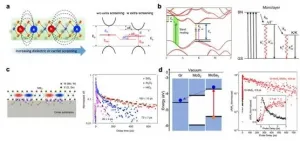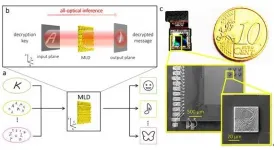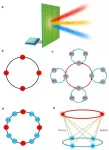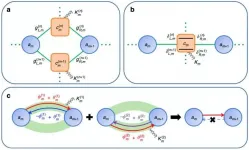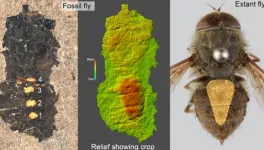(Press-News.org) The Healthy Diet Index developed by Finnish nutrition experts facilitates the assessment of diet quality. Its effectiveness was demonstrated in a recently published study.
Dietary counselling plays a crucial role in the prevention and treatment of chronic lifestyle diseases. In healthcare settings, dietary counselling is often provided by professionals without specific training in nutrition, and there is a demand for tools for reliable and easy assessment of diet quality. One such tool is the Healthy Diet Index developed in the recently completed Stop Diabetes (StopDia) project.
The Healthy Diet Index describes the quality of the diet in relation to nutrition recommendations, and to a diet that prevents type 2 diabetes. The scale of the index is from 0 to 100. In addition, the Healthy Diet Index also gives a score to different domains of the diet, including meal pattern, grains, fruit and vegetables, fats, fish and meat, dairy and snacks and treats. The aim was to create scoring method that is sensitive even to minor changes in eating habits, which facilitates the monitoring of changes and may give additional motivation to implement dietary changes.
The Healthy Diet Index was created in collaboration between nutrition experts from the Finnish Institute for Health and Welfare, the University of Eastern Finland, Tampere University Hospital and Pirkanmaa Hospital District. The Healthy Diet Index is based on a validated food intake questionnaire previously developed and used as part of Finland's national programme for the prevention and care of diabetes (DEHKO). However, it is difficult to perceive the whole diet on the basis of individual questions. Dietary counselling is easier and more concrete for the client when the diet is assessed as a whole instead of individual nutrients, and when food-specific advice is given.
The recently published study compared the Healthy Diet Index to the nutrient intake calculated from food diaries (n = 77). The researchers also examined the association of the Healthy Diet Index score with the risk factors of chronic diseases in 3,100 people who had an elevated risk of developing type 2 diabetes, and who participated in the StopDia study. The Healthy Diet Index score was found to associate with the intake of energy nutrients, fibre, and several vitamins and minerals. In the StopDia dataset, a higher Healthy Diet Index score was associated with a lower body mass index, waist circumference, and blood glucose and triglyceride levels in both men and women. The study was published in International Journal of Environmental Research and Public Health.
"The results provide support for the importance of dietary changes in the prevention of chronic diseases such as type 2 diabetes. Even minor improvements to eating habits are important for health, when they are repeated daily. The impact on health is visible even if a person's weight does not go down," says Early Stage Researcher Kirsikka Aittola, who is writing a PhD thesis on the StopDia Study at the University of Eastern Finland.
Scoring methods measuring diet quality have been developed also in the past, including the DASH index for the prevention of high blood pressure, but these often require completing a time-consuming food frequency questionnaire.
"The new Healthy Diet Index is fairly similar to previous scoring methods, but it also assesses the meal pattern, which has often been highlighted as a stumbling block in weight management when working with patients. Importantly, the Healthy Diet Index has been created on the basis of the nutrition recommendations," Professor of Nutrition Therapy Ursula Schwab from the University of Eastern Finland says.
The food intake questionnaire is easy and quick to fill out but computing the Healthy Diet Index requires automation.
"An automated and clearly visualised Healthy Diet Index would be an excellent tool for healthcare professionals to support dietary counselling. It would therefore be important to integrate it into electronic healthcare services and different digital care paths. It could also serve as a self-monitoring tool for patients, and it could include clear tips on how to make dietary changes based on one's own responses," Aittola says.
INFORMATION:
Research article:
Lindström, J.; Aittola, K.; Pölönen, A.; Hemiö, K.; Ahonen, K.; Karhunen, L.; Männikkö, R.; Siljamäki-Ojansuu, U.; Tilles-Tirkkonen, T.; Virtanen, E.; Pihlajamäki, J.; Schwab, U. Formation and Validation of the Healthy Diet Index (HDI) for Evaluation of Diet Quality in Healthcare. Int. J. Environ. Res. Public Health 2021, 18, 2362. https://doi.org/10.3390/ijerph18052362 Link: https://www.mdpi.com/1660-4601/18/5/2362
The food intake questionnaire and the scoring of the Healthy Diet Index are available at: https://sites.uef.fi/stopdia/material-bank/?lang=en
For further information, please contact:
Kirsikka Aittola
Authorised Nutritionist, Early Stage Researcher
University of Eastern Finland, Institute of Public Health and Clinical Nutrition
kirsikka.aittola(at)uef.fi
Tel. +358 50 5976 786
Twitter: @StopDiaFinland
http://www.stopdia.fi
Ursula Schwab
Professor of Nutrition Therapy
University of Eastern Finland, Institute of Public Health and Clinical Nutrition
ursula.schwab(at)uef.fi
Tel. +358 40 3552 791
Jaana Lindström
Research Manager, National Institute for Health and Welfare
jaana.lindstrom (at) thl.fi
Tel. +358 29 5248 635
Auli Pölönen
Coordination Manager, Pirkanmaa Hospital District
auli.polonen(at)pshp.fi
Tel. +358 400 723 670
Dietary and infant feeding guidelines should be strengthened to include more practical advice on the best ways to support children to learn to like and eat vegetables, say nutrition and dietetics researchers from the Flinders University Caring Futures Institute.
With the Australian Health Survey showing only 6% of children aged 2-17 years are eating the recommended amount of veggies, experts say more tailored practical advice is needed on how to offer vegetables to young children through repeated exposure and daily variety in order to increase their intake.
A recent paper co-authored by researchers from Caring Futures Institute and CSIRO, Australia's national ...
Patients suffering from dry eye disease symptoms have a lower quality of life compared to those without symptoms, a new study reports. The findings showed that patients with the condition reported negative effects on visual function, their ability to carry out daily activities and their work productivity.
Dry eye disease is a common condition and a frequent reason for patients to seek medical care. It can affect people of any age but is most prevalent in women and in older people. Symptoms include irritation and redness in the eyes, blurred vision, and a sensation of grittiness or a foreign body in the eye. It has been reported that up to a third of adults over 65 years old have the condition, although the actual number is likely to be higher as there is no established ...
Two-dimensional (2D) semiconductors can host a rich set of excitonic species because of the greatly enhanced Coulomb interactions. The excitonic states can exhibit large oscillator strengths and strong light-matter interactions, and dominate the optical properties of 2D semiconductors. In addition, because of the low dimensionality, excitonic dynamics of 2D semiconductors can be more susceptible to various external stimuli, enriching the possible tailoring methods that can be exploited. Understanding the factors that can influence the dynamics of the optically-generated excited states represents an important aspect of excitonic physics in 2D ...
Today, machine learning based methods are of our everyday life, with millions of users every day unlocking their phones through facial recognition or passing through AI-enabled automated security checks at airports and train stations. Traditionally, the processing of information native to the optical domain is being executed in the electronic domain, requiring energy-hungry specialized electronic hardware and conversion between the two realms. Optical machine learning is emerging as an important field, where the processing of optical information is done directly within the optical domain, power-efficient and at the speed of light.
Machine learning tasks, such as pattern recognition or image classification, rely heavily on the multiplication of large matrices, a resource-hungry ...
Spatiotemporal metasurfaces, driven by ultrafast dynamic modulations, opened up new possibilities for manipulating the harmonic modes of electromagnetic waves and generations of exotic physical phenomena, such as dispersion cancellation, Lorentz reciprocity broken, and Doppler illusions. In recent years, rapid development of information technologies have stimulated many information processing applications for metasurfaces, including computational imaging, wireless communications, and performing mathematical operations. With increasing amount of researches focused on the topic of information processing ...
Optical nonreciprocity, which prohibits the light field returning along the original path after passing through the optical system in one direction, is not only of vast interest to fundamental science, which brings us a deeper understanding of Lorentz reciprocity, time-reversal symmetry, and topological effects, but is also of great importance for realizing nonreciprocal optical and electromagnetics devices such as isolators, circulator and directional amplifiers, which are indispensable for applications ranging from optical communication to optical information processing.
However, realizing nonreciprocity is rather difficult as it requires breaking of the Lorentz reciprocity ...
Looking at the night sky, one's thoughts might be drawn to astrochemistry. What molecules inhabit the vast spaces between the stars? Would we see the same molecules that surround us here on Earth? Or would some of them be more exotic--something rarely observed or even unknown?
Recent research by a multinational team led by Prof. Robert Ko?os from the Institute of Physical Chemistry of the Polish Academy of Sciences has revealed an unusual molecule obtained and detected for the first time in laboratory conditions and also paved a smooth path to produce and further study another. Now that they can be seen and studied, they may prove worthy ...
Until now, it was only possible to optimize an acoustic cloaking structure for the air-environment. However, with this latest research, Acoustic cloak designed by topology optimization for acoustic-elastic coupled systems, published in the latest Applied Physics Letters, it is possible to design an acoustic cloak for underwater environments.
In the conventional topology optimization of acoustic cloaking, the design method was based on an analysis that approximated an elastic body in the air as a rigid body. However, since the approximation holds only for materials that are sufficiently ...
Two types of materials are better than one when it comes to solar cells, as revealed by an international team that has tested a new combination of materials and architecture to improve solar-cell efficiency.
Silicon has long dominated as the premier material for solar cells, helped by its abundance as a raw material. However, perovskites, a class of hybrid organic-inorganic material, are a viable alternative due to their low-cost and large-scale manufacture and potentially higher performance. While still too unstable for full commercialization, they might become available to the market by 2022.
KAUST's Michele ...
It was not the fly itself that caught the scientists' attention, but its bulging abdomen suggesting it was still full with the fly's last food intake. Surprisingly, analysis of the stomach content revealed it was full with pollen from different plants. The fossil pollen from the fly's stomach was used to reconstruct the ancient environment inhabited by the fly, the biotic interactions between plant and fly, and the fly's behaviour during feeding.
Flies as pollinators
Today, bees, butterflies and bumblebees are the typical pollinators, which are also known to feed on pollen. That flies also play an important role in pollination ...


